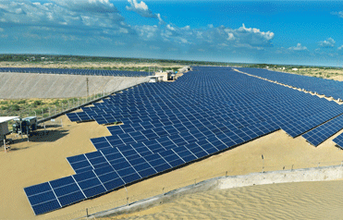
No time to rest
With this experience under its belt, the team lost no time in executing a 15MWp project - three times bigger than the debut project, and to be completed in half the time - in Gujarat. The project was in the Solar Park at Charnka, Patan district, approximately 230km from Ahmedabad. The land was waterlogged and muddy until early October because of the heavy rains.
Fortunately, it was relatively flat and did not need much levelling or grading. However, soil characteristics varied from location to location, sometimes within a few metres. Besides, 15,864 pile foundations had to be made for module structure mounting, along with the construction of 14 inverter rooms, a control room and a 66kV switchyard.
The first foundation was dug on 14 November, 2011, and the plant needed to be commissioned by January 28, 2012. Multiple contractors were engaged for each job and separate areas earmarked for them. Part of the work was not contracted out, but given to the contractor who finished his work first.
Training and retraining labour on a continual basis was a major task. Moreover, the government had allotted three pieces of land: two adjoining pieces, with a passage for villagers, and a bigger piece across the road. All three land parcels had different characteristics, and multiple foundation designs had to be employed.
Work in the first parcel went off smoothly; on an average, piling work could be ramped up to 400 foundations per day. But bores collapsed soon after drilling in the second and third parcels, affecting the pace of civil work. However, all the foundations were completed by January 2.
On-time delivery of materials at site was the next biggest challenge. Many of the imported components had to be airlifted. Work proceeded smoothly and team members, vendors, EPC contractors and Spanish engineers worked tirelessly through Christmas and New Year holidays to meet the deadline.
HIGHLIGHTS
|
Vituza has roughly 5.50 peak sun hours per day. Though sunlight is available for more than 11-12 hours, intensity varies through the day. The integrated intensity during the day on a base of 1,000W/m2 is termed ‘peak sun hours'. The solar plant loses energy due to temperature, electrical resistance, inverters, transformers, dust and manufacturing variability. On an average, 25 percent of energy is lost. Only 75 percent eventually makes its way to the tariff meter. A 5MWp plant in Rajasthan gives an output of approximately 7.75 million units (kWh) of green electricity per annum. It mitigates 6,355 tonnes of carbon dioxide in a year and 158,875 tonnes in its lifetime. The life of a solar plant is 25 years, with ‘life' defined as the time by which the output of the plant drops to 80 percent. |



































